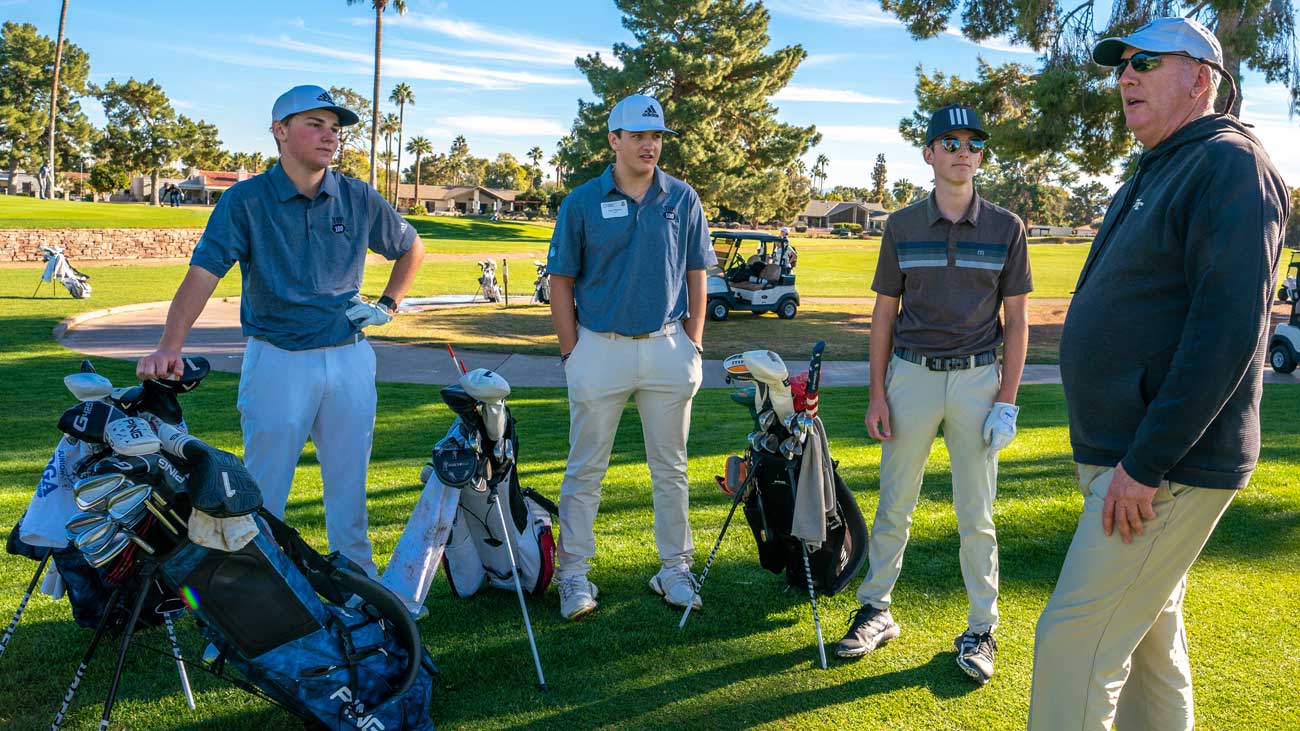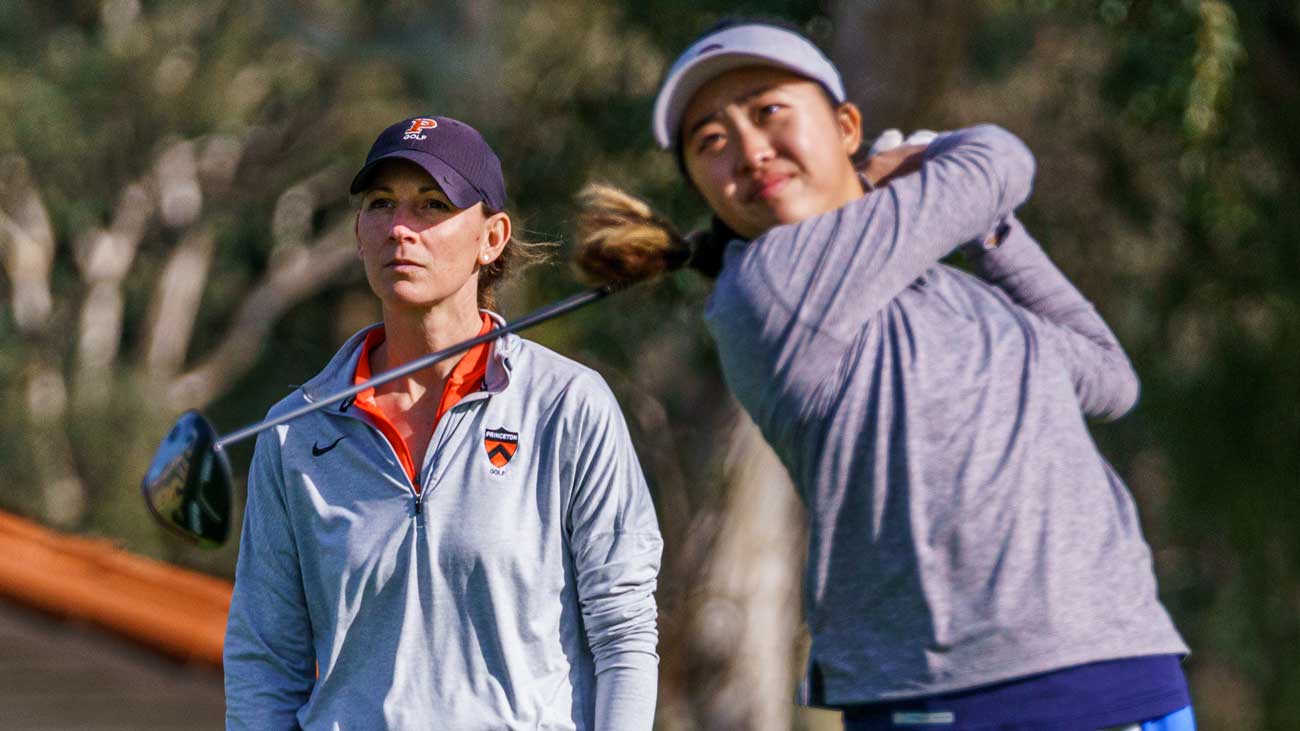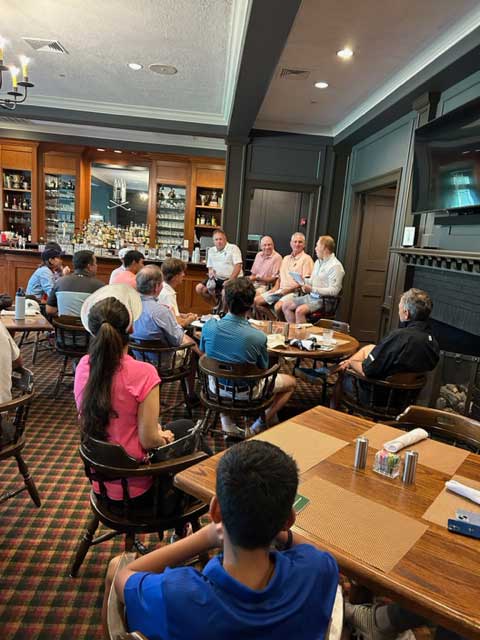
College Golf Experience camps aim to create the “connective tissue” between junior golf and college golf.
Brian Walters Photography
The college golf experience — varsity jackets, rollicking team van rides, a line or two on the résumé: It’s the dream for promising junior players. And the College Golf Experience is happy to provide it, at least for a couple of days, while kids are still in high school, trying to figure out their eventual alma mater.
Top-tier junior golfers generally look to the nation’s powerhouse college golf programs, like Texas and OSU and Arizona State. But the most famous of the nation’s powerhouse academic institutions, the universities of the Ivy League, also sport competitive Division I golf programs with storied histories and excellent facilities. For many student-athletes, and their parents, an acceptance letter from one of these schools and a spot on the team are the winner’s trophy and giant check rolled into one (even if the giant check is the one they might be sending to the university each semester).
And it was the parents themselves who received the first round of applause at a recent, two-day “Ivy Golf Institute” at Princeton University, in New Jersey. Per his custom, Joshua Jacobs, founder and CEO of CGX (no, not CGE), asked the boys and girls present — 32 of each, a full house — to express their gratitude to the people who put so much time and effort into their offspring’s current and future success. Jacobs is a high achiever himself, a former Emory University golfer and serial sports entrepreneur who began the business two years ago. The camp costs the parents $1,700 plus expenses, and the clapping was a nice start on the road to filial payback.

Brian Walters Photography
CGX launched in June 2021 with the exclusive endorsement of the Golf Coaches Association of America (some of whose members apparently had been previously burned by shady operators in the space). There were three CGX camps that year; in 2022, there were 27, and 65 will take place by the end of 2023. Jacobs is expecting to at least double that number next year. They’re held for individual schools and for groups of Division III colleges; there are “area showcase” camps and “tournament preview” camps prior to AJGA events where coaches help campers figure out how to attack the course; there are four annual cream-of-the-crop “Top100” camps that feature 24 top-ranked college golf coaches and institutions. NIL questions? CGX has answers. Whatever you aspire to in college golf, there’s a camp, or a progression of camps, to give you a sense of how to get there and what you might be getting yourself into.
“What we’re doing is creating the connective tissue between junior golf and college golf,” Jacobs said.
On my visit — I was there with my rising high-school junior, Ike — the teens were separated into boys’ and girls’ groups for the introductory seminar. Each boy was asked to stand, state his name and hometown, and one thing he hoped to gain from the camp. After most gave the expected answers (variants of “I’m here to learn what it’s like to be on a college golf team”), kudos to the boy who said, “I need to improve my chipping — it sucks!” He got a deserved laugh, and I’m guessing he makes it big in sales one day.
Then came the wisdom, from four wise old heads: Princeton men’s coach Will Green (24 years in the job), Cornell’s Matt Baughan (20 years), Columbia’s Rich Mueller (17 years) and Dartmouth’s Rich Parker (17 years). It was a mix of the practical (“You really have to manage your time”) and high-minded (“You are not your golf score”), the detailed and the general, golf and life. A few highlights among dozens, hastily scribbled in my notebook.
“We recruit kids we want to sit down for Sunday dinner with.” (Mueller)
“You build lifelong relationships in the van.” (Baughan)
“You need to really, really love golf to play college golf.” (Green)
“I want to know, what do you do after a double bogey?” (Parker)
The hour flew by such that the kids didn’t get antsy, even with a beautiful course, Springdale Golf Club, Princeton’s home track, beckoning beyond the window. As for the parents, Chihoe Hahn, whose son Andrew had arrived with one particular Ivy atop his wish list — joined by the remaining trio in a four-way tie by camp’s end — turned to me when it was over and said, “I think we got our money’s worth already.” (He later added, “It’s really not that expensive…when you consider how much we have to pay for everything else in golf!” Golf Econ 101 is indeed graded on a curve.)
The rest of the morning was spent rotating between four “Skills Stations”: course management, chipping, putting and full swing. Ike started in course management, where he learned that the first rule of double bogeys in college is: Don’t Make Double Bogeys in College!
“We love pitch-out bogeys,” said Erika DeSanty, who coaches Princeton’s women’s team. That’s because teams play five players and four scores count, so blow-up holes that lead to blow-up scores not only take you out of the game but heap pressure on your teammates, who with modern, live scoring on smartphones might be only too aware of your mishaps. As Dartmouth’s Parker said, rather firmly, “In college golf, you’re playing for your team.” There’s no “I” in “team” and no more 3-woods out of the rough over water, chasing birdie. The boys’ eyes widened a bit when Princeton’s Green told them that he’d contested three Ivy League titles determined by a single stroke, only one of which Princeton had won. “It could have been some decision from the 8th hole in the second round,” he said.

Brian Walters Photography
As a small child, Ike once mortified his parents on a tour of a maple syrup producer; in a blind taste-test, his was the only hand raised in a roomful of people, certain that what he was tasting was pure maple syrup, not Aunt Jemima’s. He was wrong. (“Sometimes wrong, never in doubt” could be his motto.) So it wasn’t without trepidation that I waited to hear whether his answer to the question of what ShotLink stat had proved the most important — “Greens in regulation,” Ike stated firmly — was correct. When Coach Green said, “Exactly,” I exhaled. Get that kid a scholarship! (The Ivy League doesn’t offer athletic scholarships, just FYI.)
The 45-minute seminar was chockablock with interesting takeaways. A college golf data guru has determined, for example, that having the fewest bogeys as a team produces far better results than having the most birdies. There were hard numbers cited, but I was an English major and zoned out during those specifics. At bottom, Coach Green stated, “Better course management is the best way to get better.”
Then it was onto putting with Columbia’s Coach Mueller, where the boys putted from various distances and kept track of their total putts, then compared them to the PGA Tour average. No doubt Ike took confidence from (in this admittedly small sample) being only a half-stroke higher than a pro; more important, the kids got a sense of reasonable expectations. They’re under enough pressure already, lord knows, so the sense of not beating yourself up after missing an 8-footer was surely welcome.
Next came chipping with Dartmouth’s Parker. The focus here took a page from “Walden”: “Simplify, simplify, simplify!” That is, when possible, play bump-and-runs instead of flashier, loftier shots. If Coach Parker had a podcast, I’d tune in a heartbeat — the man can spin a yarn and land a joke — but, alas, he’s a Luddite who’s not even on social media. In fact, a later discussion on social media centered not on whether you should have a golf-specific Instagram profile but rather on not being filmed doing anything stupid that would come back to bite you, in admissions or anywhere else.

Evan Rothman
The weather doesn’t care how much you may have paid for a camp, and thunderstorms threatened and occasionally acted upon those threats throughout the day. So, Ike and his group never made it to the full-swing session with Coach Baughan of Cornell. When one of the kids groaned, “No range time before the practice round?” Dartmouth’s Mueller didn’t miss a beat: “Welcome to college golf.”
After lunch and before the weather returned, the practice round underscored that, as Coach Green said, “A practice round isn’t about practicing — it’s about gaining knowledge.” As such, the coaches would discuss best places to leave one’s approach, best lines to take off the tee, the shot shape that widens the landing area, and so on. Chip shots were instead sometimes tossed into bunkers by a coach, to ensure a player got a feel for the sand. Score was not the point. And to their credit, none of the kids seemed shy about sidling up to any of the coaches to ask questions and maybe get on their radar, too. Networking is part of the point.
As a parent, it was particularly gratifying to see that the kids immediately began policing themselves. With more groups than coaches to follow them, the boys and girls were on their own for holes at a time, and they took to heart what they’d been told, hitting putts to and from a few different spots on the green, testing the sand, not sweating tap-ins. They were clearly coachable.
They were also kids, ones whose interests thankfully seem to extend beyond golf. I followed a boys’ group (not Ike’s, because we’ve both recognized that it’s best for us to go our separate ways on course) and caught snatches of their conversation: Bronny James’ pro prospects, bands I wasn’t familiar with, the slenderness of Nelly Korda’s ankles.
Back to class. Jacobs emceed the “College Recruiting Seminar,” a Q&A covering the key dates around recruiting contacts, campus visits, academic info, what kinds of tournaments to play to appeal to coaches, and so on. For many people, yours included, it is all daunting verging on overwhelming, but this was a knowledgeable crowd, and there was a fair amount of nodding as well as copious notetaking. Beyond the specifics and timetables, the nuts and bolts, there was still more thoughtful counsel. The Cliff Notes version:
“You have to be your own best marketer and advocate.” — Coach Mueller
“Be honest with yourself.” — Coach Baughan
“Think critically for yourself — it’s not about your parents.” — Coach DeSanty
“Make it personal — do your research on the school and the program…and for god’s sake don’t mix up our names and schools! I get letters, ‘Coach Mueller, I really want to play at Dartmouth….’” — Coach Parker of Dartmouth

Evan Rothman
The next morning, under still-threatening skies, the kids set out for their quasi college-tournament round. Coaches were scattered around the course, offering advice to players both proactively and when asked, talking shop between themselves at times, and, yes, scouting for talent.
“I’m always recruiting,” said Princeton’s DeSanty.
Yet the mood was far more relaxed than any junior tournament I could recall. Maybe it was because, while the kids were expected to turn in their scores, it wasn’t really a tournament round but a learning experience. Maybe it was because these were parents and children who bought into the camp’s stated purpose.
As the kids played, I fell into conversation with the mother of a girl in the camp. She told me that she’d “made every possible mistake” with her older son’s golf—that after a miserable semester at a college beneath his academic level, he’d quit both the golf team, the school, and golf itself, returning home to start over.
“We’re being very careful with my daughter, making sure she is the one steering the ship,” she said. “Whatever you do, make sure your son does what’s best for him—that the school is there for him, he’s not there for the school.”
As it happens, her daughter soon made the turn. Mom came over to snap a picture of her with the money-shot backdrop— the Gothic spires of Princeton’s Cleveland Tower. Keepsake complete, the girl began working toward the next tee. “Love you, baby — have fun!” said Mom. “Thanks, Mama!” daughter chirped in reply.
It was hardly the last heartwarming moment to push back against the narrative of stressed-out, Type A+ golf families running amok. I followed a random group for a few holes and, when one girl’s playing partner’s approach looked as if it might not clear a cross-hazard, she murmured to herself, “Get over.” It did. Sportsmanship and kindness are alive and well in golf, thank you.
Back on Springdale’s veranda, I watched Ike walk in following his round with the other two members of his group, one boy from Morocco and the other from China. They’d come as part of their U.S. summer tour, to play tournaments and attend camps. The three chatted away like old pals. You can get an education anywhere, Ivy League college or school of hard knocks, and the fairways and greens almost always provide one.








